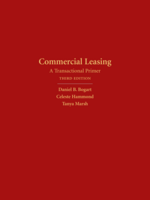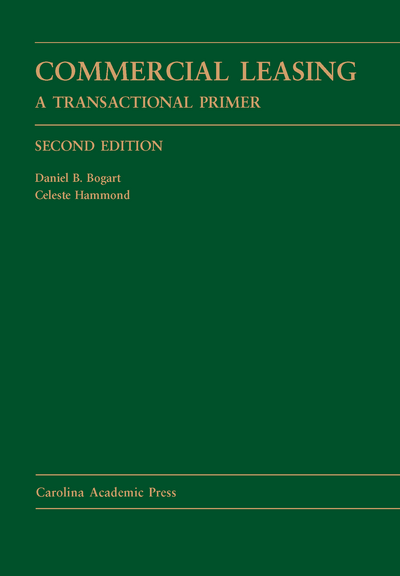This title has been replaced by a newer edition:
Commercial Leasing: A Transactional Primer, Third Edition
2020, 622 pp, casebound, ISBN 978-1-5310-1188-8
$105.00
Teacher's Manual available
Commercial Leasing (Paperback)
A Transactional Primer
Second Edition
by Daniel B. Bogart, Celeste Hammond
2019
Tags: Commercial Law; Property/Community Property; and Real Estate/Mortgage Law
Teacher's Manual available
542 pp $75.00
ISBN 978-1-5310-1632-6
This is the 2019 paperback printing of the Second Edition of the casebook published in 2011. The Third Edition, with new co-author Tanya Marsh (Wake Forest University School of Law) joining Daniel Bogart and Celeste Hammond, will be available in December for spring 2020 use. It will be a traditional hardback and will meet ABA experiential learning requirements as well as the learning outcome standards recently adopted by the ABA.
This book is the first among legal textbooks to examine a crucial component of real property practice: commercial lease law. Commercial leasing is the lifeblood of commercial real property development in the United States. Real property lawyers regularly represent landlords, tenants and lenders in the leasing of commercial space. This is true in periods of booming real estate development, as well as in periods of economic downturn. Leasing practice is transactional and centers on a single negotiated document — the commercial lease. By the end of a course based on this book, students will have developed a genuine understanding of the major terms of the commercial office lease, the goals and objectives of parties to the transaction, and the skills crucial to effective representation.
Bogart and Hammond have crafted a book uniquely suited to teaching this important area of practice. The book utilizes a sophisticated commercial office lease form promulgated by the ABA. Each chapter focuses on a particular lease provision. Chapters pull apart contractual language and terms of art, reveal the motivations of the parties to the deal, and finally, examine the underlying substantive law. In addition to presenting interesting case opinions, each chapter provides numerous challenging, real-world problems. Chapters typically conclude by asking students to apply what they have learned to provisions taken from the much-publicized "Killer Lease."
The book includes a chapter explicitly discussing professionalism, ethics and negotiations, and contains drafting and negotiation exercises that force students to pull together skills and substantive law lessons. This second edition also includes new problems patterned on authentic leasing practice as well as recent important cases. In much the same way that real estate lawyers confronted newly developed environmental law a generation ago, real estate lawyers today are learning how to meet client demands that leaseholds and leasehold contracting satisfy standards of resource sustainability. This new edition therefore includes a chapter on "Green Leasing." Real estate, property, and transactional law professors who want to help students to develop a real understanding of a transactions-based practice will enjoy Commercial Leasing. This book will form the basis of an exciting elective real estate transactions course.
"…people at [a big law firm] are impressed with my commercial lease drafting skills. After drafting two full leases for an 8th year associate (who will be made partner soon), along with praising me for my drafts, he also commented how jealous he was that I already had a great grasp of concepts that took him 3+ years to comprehend." — Recent Wake Forest University School of Law graduate who was assigned Bogart/Hammond's Commercial Leasing (in a note to the professor)
"Commercial Leasing provides a comprehensive collection of substantive law, exemplars, and exercises for an advanced transactional drafting course that allows students to build on the skills and substance that they have learned in basic contract drafting, contracts, and property courses. The book features problems for discussion in the text, as well as more extensive drafting projects in the teacher's manual, and is in part a treatise on its subject matter as well as a highly selective casebook." — George W. Kuney, Lindsay Young Distinguished Professor of Law and Director, James L. Clayton Center for Entrepreneurial Law at The University of Tennessee College of Law
"This second edition text is document driven and uses the Basic Commercial Office Lease as foundation, with excerpts presented in each chapter and problems oriented around adjusting this document for particular clients." — Book News Inc.



